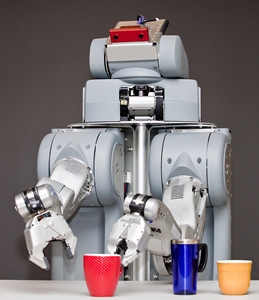6 February 2015. Computer scientists designed and tested decision-making models using artificial intelligence for robots to plan and perform unstructured and ill-defined tasks, from doing household laundry to conducting search-and-rescue operations. The team led by Siddharth Srivastava, now with United Technologies in Berkeley, California and Shlomo Zilberstein from University of Massachusetts in Amherst described their work in a paper presented to a meeting of the Association for the Advancement of Artificial Intelligence at the end of January in Austin, Texas.
Srivastava, then a postdoctoral researcher at University of California in Berkeley, and Zilberstein, with colleagues from the two schools, developed solutions to address tasks that are relatively simple, even boring, for humans to organize and carry out, but prove difficult for robots because of their undefined nature. For autonomous systems to conduct these tasks required up to now extensive algorithms that became complex and difficult to generalize to new, unstructured, or ill-defined problems.
The Berkeley-Amherst team, funded by a National Science Foundation grant, applied insights from the way humans approach the tasks, with generalized plans based on repetitive simple decisions and actions that made assumptions about the uncertainty. “These are plans that don’t just work in a particular situation that is very well defined and gets you to a particular goal that is also well defined,” says Zilberstein in an NSF statement, “but rather ones that work on a whole range of situations and you may not even know certain things about it.”
The researchers used laundry as an example of a human task with a minimum of structure — e.g., fixed locations of closet and washing machine — yet still undefined quantities and specifics of items to be washed, such as weight and colors of fabrics. The team wrote computer models, reflected in algorithms based on different types of planning and decision-making models, then programmed those algorithms into routines with loops and branches to direct the robots to first plan, then carry out the work. The models can also adapt to uncertain or unstructured situations by learning from examples, giving them more capability when confronted with previously undefined tasks.
The team tested their models on a PR2 robot, originally made by Willow Garage, a company no longer in business, but that runs on the open-source ROS operating system, and is still commercially supported. The robot was tasked with taking a stack of dirty laundry from a closet and depositing the items in a washing machine. The robot successfully gathered the laundry, placed the items in a basket, took the basket to a laundry room, placed the basket on a table, opened the washer, removed the items from the basket, placed them in the washer, then closed the washer. The researchers say determining the solution plan took the robot less than one second.
“Using this approach, solutions to high-level planning can be generated automatically,” says Srivastava. While laundry provided a convenient and familiar problem for testing the process, the researchers say it can be applied to a more consequential, tedious, and high-risk operations such as manufacturing and search-and-rescue missions.
The following brief video demonstrates the robot performing the laundry task.
- XPrize Awards $5.25M for Lunar Technologies
- Robot for MRI-Guided Epilepsy Surgery in Development
- Humanoid Robots Help Children with Autism Learn Interaction
- Farm Survey Drone System Seeks Crowdfunding Support
- University, Spin-Off Partner on Enviro Flying Robotic Device
* * *


 RSS - Posts
RSS - Posts
[…] Robotics Designed for Laundry and Other Uncertain Tasks […]